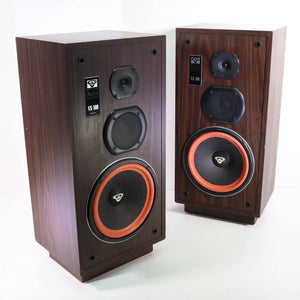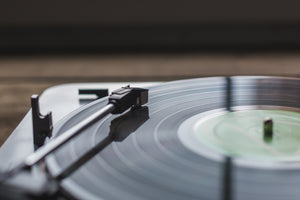We are unable to reply to comments, so please message us directly if you have a specific question regarding products, shipping costs, etc. Our office number is (480) 207-1511. Our email is hello@spencertified.com. You can also message us on Facebook. Commonly asked questions and answers can be found on our FAQs page here.

EQUALIZATION 101: A GUIDE TO AUDIO TONE CONTROL
TUNING IN: THE ART OF EQUALIZATION IN MUSIC
Have you ever turned up the bass on a song or adjusted the treble to make voices sound clearer? If so, you’ve already used equalization! Equalization is a way of changing the balance of sounds in music or audio by turning certain parts of the sound up or down. It helps make songs sound better, clearer, or more powerful, whether you're listening through headphones, in a car, or at a concert.
But if you’re new to the realm of audio, seeing all of those sliders and knobs in the “EQ” section of an amplifier may get overwhelming. But once you learn the basics of what equalization is, how it works, and why it’s used? Equalization gets pretty simple, and you can use it to open up a whole side of the audio world.
WHAT IS EQUALIZATION?

Equalization (often shortened to just “EQ”) lets you fine-tune the volume of different sound ranges in your audio—think of it as having separate dials for booming bass, clear vocals, and sparkling highs. It’s similar to volume control, but rather than adjusting the overall loudness of your music, equalization lets you tweak the specific sound frequencies independently.
Even though tracks are already EQ’d during mixing and mastering, and again a second time when converted to various formats, your ears might crave a little extra bass punch or crisper mids. Think Goldilocks and the Three Bears: Sound is subjective, and while to one person an audio clip may sound too high, and to another it sounds too low, to you it may sound just right. Equalization is used to fine-tune your sound just the way you like it.
EQ also helps tailor sound to your room’s quirks—like echoey walls or cozy furniture—that can muddy or harshen your tunes. It’s also handy for different activities. If you’re in the middle of a hard-hitting workout, bass may be something you want to have a stronger punch. But if you’re watching a movie with lots of dialogue, then adjusting the mids can make those vocals pop.
EQ AND THE THREE FREQUENCIES

Now that we know what equalization is, let’s take a closer look at what it’s actually doing.
In general, the ranges that EQ adjusts can be broken down into three bands: low frequencies, middle frequencies, and high frequencies. Each is measured in hertz (Hz), which is the number of sound wave cycles that happen per second. So lower numbers mean lower-pitched sounds while higher numbers mean higher-pitched sounds.
Here’s a breakdown of what each range specializes in:
-
Low Frequencies (20 Hz to 200 Hz): It’s all about the bass! These frequencies bring the deep, rumbling bass that make your subwoofer hump. They add punch, but too much bass will overwhelm the other frequencies and turn your music into a muddy mess.
-
Middle Frequencies (200 Hz to 4 KHz): This is where vocals and lead instruments shine. If the mids get buried, vocals and guitar solos disappear into the background, leaving the music to feel a bit flat.
-
High Frequencies (4 KHz to 20 KHz): AKA: the treble. Cymbal crashes and soprano solos live in these higher frequencies and are the sparkle that wakes up your music. If this band is overdone, then the audio will sound sharp and harsh.
THE FOUR DIMENSIONS

Not all amps are built the same. However, on most pieces of vintage audio gear, whether it be a preamp, integrated amp, or receiver, you’re likely to notice four knobs that are usually grouped together: Bass, Treble, Balance, and Volume / Loudness.
Adjusting EQ on the amp itself (rather than for each individual component) not only saves time, it also saves your settings on a system level, so your music sounds equally incredible across the board. To adjust, put on a song, then play with each knob until you get the sound you like.
Here’s an overview of what each setting does:
-
Bass: Adjusts the lower frequency sounds, like basslines and kick drums.
-
Treble: Controls the higher frequency sounds, such as guitars and vocals.
-
Balance: Fine-tunes the volume level between left and right channels.
-
Loudness: Enhances certain frequencies, including bass, to offset the ear’s reduced sensitivity at lower listening volumes, ensuring consistent sound quality across different volume levels.
Many stand-alone preamps do have additional buttons that let you experiment further with your sound. These processors automatically adjust the specific frequency ranges for you in order to recreate a certain listening environment, such as a concert hall, stadium, or theater.
DEDICATED EQUALIZERS

In addition to the built-in equalizers you see in preamps, amps, and receivers, there are also stand-alone graphic, parametric, analog, and digital equalizers you can invest in. These have multiple frequency bands. Each frequency band has variable frequency gain that's measured in decibels (dB). Depending on the EQ, each one will have a different number of sliders or knobs; the more controls there are, the more control it will have over specific frequencies. A 12-band equalizer will be cut into more frequency bands than a 7-band equalizer.
They also have different frequency bands. For example, a ten-band graphic equalizer may have adjustable frequencies of 30Hz, 60Hz, 120Hz, 250Hz, 500Hz, 1kHz, 2kHz, 4kHz, 8kHz, and 16kHz. These equalizers typically come with simple sliders you can play around with to tweak the character of your sound and affect your music’s overall sonic profile.
The purpose of these dedicated equalizers is to adjust the more minute aspect of the entire sound curve, which allows you to craft a more fine-tuned sound than those that break the curve down into those three frequency ranges.
IN SUMMARY
In the world of music and audio production, sound is more than just what we hear—it's a carefully sculpted experience. At the heart of shaping that experience lies equalization. Whether you're an audiophile who can hear those minute differences in high pitch or a casual listener adjusting the bass on your favorite playlist, equalization is a powerful tool. From removing unwanted frequencies to emphasizing the richness of a vocal or the punch of a drum, EQ plays a critical role in how audio is perceived and enjoyed.
And now that you know the basics? You’re ready to start tweaking your sound! And if you’re interested in trying out a dedicated equalizer, we have you covered! You can find our refurbished equalizers here.
Thanks for reading! Have a great day.
https://spencertified.com/collections/equalizer



Leave a comment